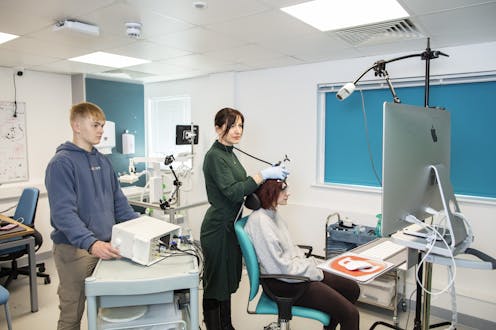Ultrasound waves zapped at the brain are being used to treat everything from hand tremors to addiction
Is the future of mental health treatment ultrasound waves?

One in four people has a mental disorder, according to the World Health Organization. If you’re lucky enough to live in a wealthy country, treatment will usually involve some form of medication – which can cause more issues than it fixes.
The reason for that lies in the depths and complexities of the human mind. It is made up of a maze of pathways that connect the different parts of the brain. They are in turn governed by chemicals that dictate our thoughts, emotions and actions. When a person has psychiatric disorders such as depression, anxiety or addiction, this intricate landscape is often clouded in shadow.
Medicating as a form of treatment touches every part of that complex system, the areas you want to treat and everywhere else besides. However, research is uncovering a light at the end of this metaphorical tunnel – a technique that uses ultrasound to change how the brain behaves.
When people hear the term ultrasound, they probably think of the scans used to monitor the early development of babies in the womb. In that context, it works by emitting gentle waves of sound, and when they bounce off different parts of the body, they create “echoes” that are turned into a moving image.
The notion of using the same methods to modulate brain activity might sound like something out of a sci-fi novel. But it is grounded in solid scientific principles.
Focused ultrasound involves the targeted delivery of sound waves to specific regions of the brain, where they can influence brain activity. And unlike other forms of brain stimulation, such as transcranial magnetic stimulation or deep-brain stimulation, the use of transcranial ultrasound stimulation (TUS) offers several distinct advantages.
For starters, it is non-invasive, meaning there’s no need for surgery or implantation of electrodes. The ultrasound machine is simply positioned onto the hair with gel and delivers ultrasound.
This not only reduces the risk associated with invasive procedures, but also makes it more accessible to a wider range of patients.
Also, focused ultrasound can precisely target deep brain structures with unprecedented accuracy, allowing for personalised interventions that address the root causes of brain disorders, whether neurological, like essential tremor or psychiatric, like addiction.
This level of precision holds the promise of personalised medicine, where treatments can be tailored to individual patients based on their unique brain organisation and symptoms.
Vast and varied
The potential applications of focused ultrasound in treating brain disorders are vast and varied. Notably, one of the most remarkable findings is its ability to reduce tremors in individuals with essential tremor by targeting the deep brain regions responsible for excessive movement.
In depression, researchers have also explored its ability to change the activity in the dorsolateral prefrontal cortex – a region of the brain that has been implicated in mood regulation. By gently nudging this area with ultrasound waves, scientists hope to alleviate symptoms of depression and restore balance to the brain’s emotional circuitry.
Similarly, TUS shows promise in anxiety disorders, where aberrant activity in the amygdala – an almond-shaped structure involved in fear and stress responses – can contribute to pathological anxiety. By precisely targeting the amygdala, researchers aim to dial down its hyperactivity, offering relief to those plagued by incessant worry and dread.
Even more complex conditions like addiction, characterised by disruptions in reward sensitivity, cognition and social functioning, may benefit from TUS interventions. Some UK research teams are currently working on a trial looking at its potential to address alcohol addiction. By modulating activity in brain regions associated with reward, the hope is to mitigate the debilitating effects of the disorder and improve patients’ quality of life.
Read more: Magnet therapy for depression is available on the NHS – here's how it works
The complexity of psychiatric disorders poses another significant hurdle, and imagining this as a one-size-fits-all solution is perhaps fanciful. But this is a field where treatment options are limited and outcomes vary widely. Against that, the prospect of precise brain interventions that target the root causes of psychiatric disorders could revolutionise psychiatric care and offer hope to millions around the globe.
As the mysteries of the brain are continuously refined and technology can allow us to reach its deeper parts, there is hope that we will find ourselves on the brink of a new era in mental health care, where the shadows of psychiatric disorders are illuminated by the healing power of sound.
Elsa Fouragnan receives funding from the UKRI Medical Research Council Future Leaders Fellowship and the BBSRC grant (MR/T023007/1 and BB/Y001494/1).
